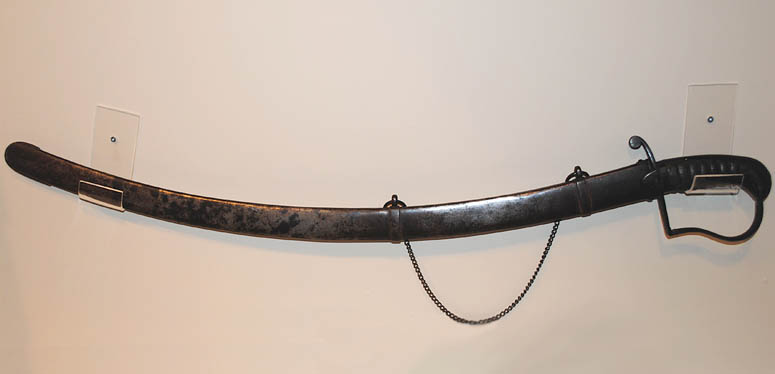
Borders & Frontiers (1800-1820)Peter Ruttan's Sword & Epaulette |
|||
|
|||
Peter Ruttan's D-Guard Light Artillery Sabre used in the War of 1812 |
The Ruttan brothers William and Peter were among the 1784 settlers to Adolphustown Township following the American Revolution. William, commissioned a Lieutenant in the Associated Loyalists, settled on Lot 18, 1st Concession in Siegneurie No. 4 (Adolphustown). His brother, Peter, commissioned a Captain in the Associated Loyalists, settled at Ruttan's Point in the third concession. DISCOVER MORE![]()
Peter joined General Howe's army in 1776 and served as a Captain in the 4th Battalion, and later the 3rd Battalion, New Jersey Volunteers. He accompanied Chief Joseph Brant on a tour of observation from New York to western Canada in 1778. At the end of the war, he was commissioned a Captain in the Associated Loyalists (discharged soldiers and civilian refugees) who were about to leave New York for Quebec, aboard the ship Hope. Arriving in Quebec on August 14, 1783, they wintered at Sorel before moving up river to Adolphustown.
The second session of the Parliament of Upper Canada passed a Militia Act, obligating all males from 16 to 50 years of age to enroll in a "Sedentary Militia"of regiments whose companies were mustered and inspected bi-annually. The Militia was organized into regiments and companies based on counties.
The 1st Regiment Lennox Militia was raised in the townships of Adolphustown, Fredericksbugh and Richmond. Hazelton Spencer, formerly a Lieutenant in the 2nd Battalion, King's Royal Regiment of New York, was Colonel from 1794-1813.
In June 1812, the United States declared war on Great Britain, angry that the Royal Navy's blockade of French ports was interfering with their Atlantic trade and that the Royal Navy persisted in searching for British deserters on their ships. Upper Canada, as a colony of Great Britain, was drawn into the conflict.
Kingston, home to the Provincial Marine since 1784, was the most important military station and dockyard in Upper Canada. Late in 1812, Point Henry at Kingston was fortified to provide protection to the dockyard at Point Frederick. West of Kingston, two cannon were planted at Herchimer's Point, a location which afforded a view of the upper gap.
Under General Isaac Brock, able bodied men were recruited into "flank companies", special militia companies designed for regular service. In the 1st Regiment Lennox Militia, Thomas Dorland commanded a Flank Company. Captain Peter Ruttan's son, Joseph Brant Ruttan, named after Chief Joseph Brant, served as a Private in Captain Thomas Dorland's Flank Company, 1st Regiment, Lennox Militia. Another son, Abraham was a Private in Captain Owen Richards Company of the 1st Regiment Prince Edward Militia. Their cousin, Peter William Ruttan, son of Captain Peter's brother, William, also served in 1812 as a Sergeant in Captain Thomas Dorland's Company.
Captain Thomas Dorland's Flank Company was involved in a skirmish at Herkimer's Point when an American fleet of seven vessels under Commodore Chauncey pursued the Royal George through the channel between Amherst Island and the mainland to Kingston. On November 17, 1812, the Kingston Gazette reported that, "last Tuesday, seven American vessels full of men were approaching ... On their way down the Bay of Kenty [sic] in the morning, they burned a small schooner [the Two Brothers] belonging to Messrs. B. Fairfield and Co.."
In 1813, Peter William Ruttan was at Kingston in Colonel Cartwright's Battalion of Embodied Militia. Family history relates that after the capture of the Fort at Ogdensburg in February 1813, he helped to remove the ammunition, stores and cannon to Canada.
Peter William Ruttan served as a Sergeant in Captain Nicholas Hagerman's Company, Lennox Sedentary Militia from April 30 – May 6, 1813. His cousins Joseph and John Ruttan served in Captain Luke Carscallen's Company of Embodied Militia from 25 September – 24 October 1813.
In the fall of 1813, there were fears and rumours that an American fleet would pass up the Bay and take possession of the thinly settled countryside. The Kingston Gazette, October 9, 1813, announced the arrival of the 104th Regiment, the 49th Regiment and the Corps of the Voligeurs to bolster the garrison at Kingston. The militia had already assembled in considerable numbers from the surrounding countryside. The attack came in November 1813, but further east at Chrysler's farm, Morrisburg.
Peter William Ruttan's brother, Henry, served as a Sergeant in Captain John Spencer's Flank Company, 1st Regiment Northumberland Militia and as a Lieutenant, 2nd Battalion of Lt- Col. William Robinson's 8th Regiment of Line in 1813. He was wounded at the Battle of Lundy's Lane in July 1814. Following the war, he was made a Major of Militia, then a Colonel.
The Ruttan officer's sword is handed down through Peter William Ruttan. It is a D-guard light artillery sabre with a single-sided blade, 80 cm in length, and includes a steel hilt and pommel cap. Accompanying the sword is a steel scabbard with suspension rings, and a single epaulette from his uniform, which is made of canvas and includes a fastening slit with gold metallic braid. The epaulette is backed with leather and tin.
© Lennox & Addington County Museum & Archives
97 Thomas Street East, Napanee, Ontario, Canada K7R 4B9
Funding provided by the Government of Ontario and the County of Lennox & Addington




